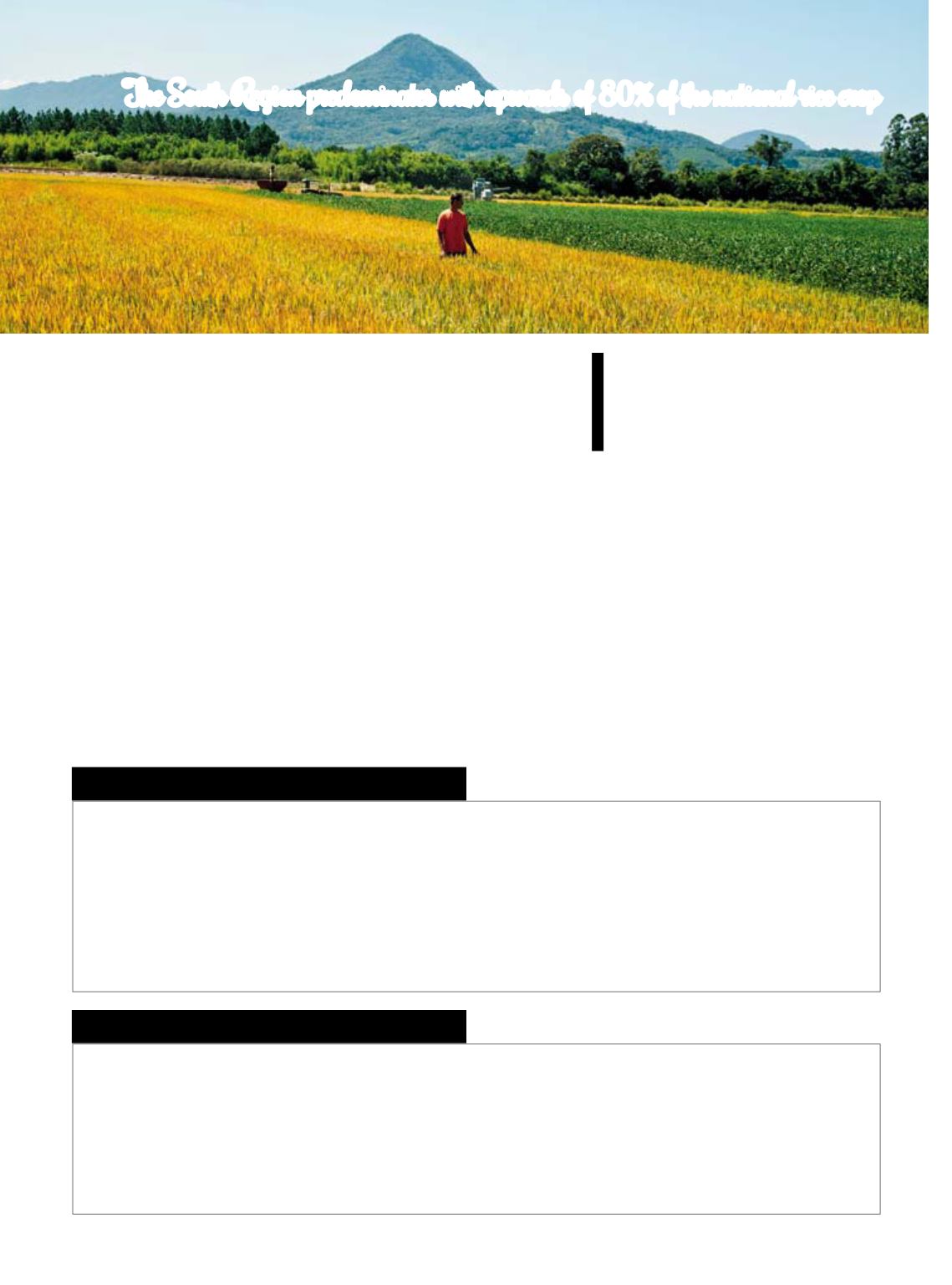
W
ith a climate neutral pro-
file, which also left its
marks on the rice fields,
Brazil is recovering its nor-
mal production volumes
in the 2016/17 growing season, after regis-
tering historical losses in the previous year’s
season, brought about by the El Niño phe-
nomenon. The March report by the National
FoodSupplyAgency (Conab) points toapos-
sible12.9%increase in the total volume tobe
harvested, a jump of 1.36 million tons, from
10.603million to11.966million tons.
The growth is based on the recovery of
earnings, despite the 0.8-percent drop in
seeded area, from 2.008 million hectares to
1.991millionhectares.“Plantingsinhighlands
and dry lands are on the decline because the
farmers can opt for the soybean/corn succes-
sion, more profitable, especially in the Cen-
ter-West and Southeast. This is generating
a concentration of upwards of 80% of rice
farming in the South”, explains Carlos Magri
Ferreira, socio-economist with Embrapa Rice
andBeans,inSantoAntôniodeGoiás(GO).
Productivity per hectare should soar
The picture released in March 2017 by
the Conab points to a 5.6-percent drop in
the harvest of dry land rice in Brazil, from
1.236to1.167milliontons.Theseededarea
fell 10.8%: from 608.7 thousand hectares
in the 2015/16 growing season 543.1 thou-
sand hectares were cultivated. It means a
reduction of 65.6 thousand hectares. The
increase of 117 kilograms per hectare, or
5.8%,inproductivity,upto2,147kilograms,
mitigates the smaller crop in thehighlands.
Mato Grosso, with 473.6 thousand
tons ready to be harvested from137 thou-
sand hectares, is the leading dry land rice
producer, followed by Maranhão (214.5
thousand tons, on 160.7 thousand hect-
ares) and Rondônia (121.8 thousand tons
and 40 thousand hectares). The highest
productivity in this agronomic model is
reached by Goiás, with an average of 3.9
thousand kilograms per hectare. Minas
Gerais has the lowest performance, where
the subsistence fields produce no more
than 850 kilograms per hectare.
n
n
n
Dry land versus irrigated
There isbig technological disparitybetween theBrazilian irrigated rice fields, a reference in theAmericas, oneof thehighest productiv-
ity rates in theworld, and in the dry land systems. The latter are still very primitive and subsistence oriented. The highlandmodel, where
genetics andmanagement technology are part of the system, also remains below the results achieved in irrigated fields, whether for the
existing technology transference problems, or for cultural aspects or, perhaps, for the objective of rice farming in these regions, generally
geared towardopeningupnewland toagricultureor for the recoveryof degradedpastureland. “If theaimdiffers fromcultivating rice, but
covering thecost of improving the land for other economicpurposes, the result isnot expressive. But thereareprofessional rice farmers in
these regions,well organizedandmakingprofits fromthis crop”, explainsCarlosMagri Ferreira, fromEmbrapaRiceandBeans.
n
n
n
Disparity
Brazil’scropmakesagood
recoveryinvolume,butstillremains
distantfromtheprofitabilityrates
expectedbymostofthefarmers
13.8%intheseason,onaccountofthefavor-
able weather conditions. “Brazil will reach
an average of 6,010 kilograms per hect-
are, almost 800 kilograms more than in the
2015/16 growing season. Climate and tech-
nologymake thedifference”, says SérgioRo-
berto dos Santos Júnior, Conab analyst.
Official statistics show that 81.6% of the
Brazilian rice crop is concentrated in the
South, with 9.72 million tons, followed by
the North (1.14 million tons), Center-West
(636 thousand tons), Northeast (412 thou-
sand tons) and Southeast (with only 55.4
thousand tons). “Areas suitable for agri-
culture, tradition, rice farming, a good pro-
cessing structure and technology account
for this status of the South. This concentra-
tion is likely to soar”, says Embrapa Rice and
Beans chief executive AlcidoWander.
No
euphoria
The South Region predominates with upwards of 80% of the national rice crop
Inor Ag. Assmann
16


